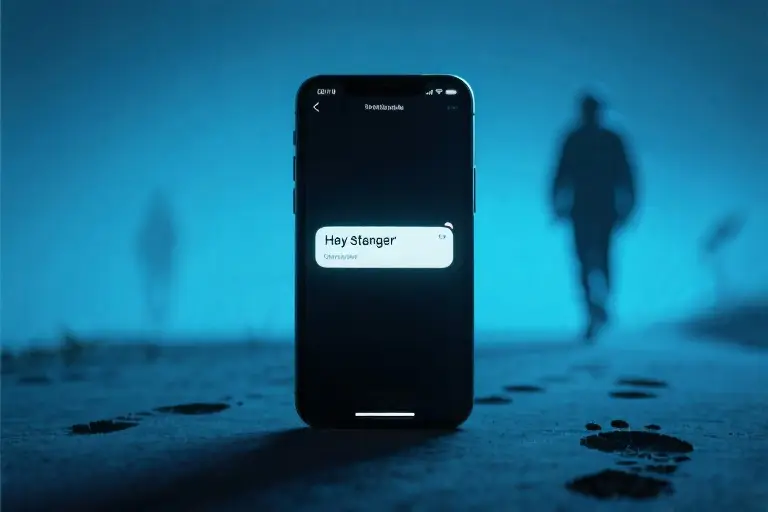The coffee appears on your desk with familiar precision—steaming cup, your exact order memorized, even that little heart doodled on the napkin. It’s the third time this week. Yet when you tentatively bring up meeting his family over dinner, his fingers freeze mid-text. ‘I’m just not big on labels right now,’ he says, reaching for your hand like a peace offering. The warmth of his palm contradicts the chill creeping up your spine. Why does his ‘just enough’ always leave you feeling perpetually shortchanged?
This is the illusion of effort in modern dating: those meticulously placed breadcrumbs of attention that mimic genuine investment. Like a vending machine dispensing snack-sized affections, these relationships operate on minimum input for maximum emotional hold. The morning texts that never progress to weekend plans. The ‘you’re so special’ declarations that evaporate when you need actual support. The sporadic gestures just substantial enough to make you question: Am I being unreasonable to want more?
Let’s dismantle that doubt immediately. What you’re recognizing isn’t neediness—it’s your intuition sounding the alarm on emotional unavailability. Healthy reciprocity shouldn’t require decoding mixed signals or rationing affection. When someone truly chooses you, their effort leaves no room for Google searches like ‘signs he’s serious.’
This isn’t about demonizing partners or reducing complex dynamics to gender stereotypes. Emotional vending machines exist across all relationships. What matters is recognizing when you’re being fed crumbs instead of invited to the feast—and more importantly, knowing you deserve a seat at the table.
The illusion thrives on three psychological hooks:
- Intermittent reinforcement: Like slot machines rewarding unpredictably, sporadic attention triggers addictive dopamine surges.
- Sunk cost fallacy: The longer we tolerate half-efforts, the harder it becomes to walk away (‘But he did bring me coffee…’).
- Social conditioning: Women are often praised for patience (‘Give him time!’) while men face fewer expectations for emotional labor.
Notice how these mechanisms make it a systemic pattern, not your personal failing. That’s why identifying illusion of effort requires zooming out from individual gestures to overall patterns. A single sweet text means little—but when it’s consistently the only form of effort across months? That’s data.
Here’s your litmus test: Does this relationship operate on a ‘minimum viable effort’ model? Much like startups using MVP (Minimum Viable Product) strategies to test markets, some partners deploy just enough affection to keep you subscribed, with no intention of upgrading to full emotional availability. The coffee deliveries aren’t stepping stones—they’re the entire product.
Breaking the cycle starts with trusting what you already sense. That hollowness after another non-committal ‘hangout’? The exhaustion from interpreting emojis like tea leaves? Those are valid compasses. Next time you’re tempted to excuse bare minimum behavior, ask: Would this satisfy someone who truly valued themselves? Your answer holds the exit door.
10 Subtle Signs of Illusory Effort in Relationships
That flutter in your stomach when his name lights up your phone. The way he remembers your oat milk preference when dropping off coffee. These micro-gestures feel like connection—until you realize they’re carefully measured doses of attention designed to maintain your interest without requiring real investment. Here’s how to spot the difference between genuine effort and emotional vending machine dynamics.
1. The Low-Cost Care Package
He’ll like your Instagram story from two weeks ago but ‘forget’ to respond to your vulnerable text from yesterday. This calculated selectivity represents classic breadcrumbing in relationships—offering just enough digital interaction to stay on your radar while avoiding substantive emotional labor. Notice whether his outreach primarily consists of:
- Reaction emojis instead of full sentences
- Memes about relationships rather than initiating real conversations
- Late-night “you up?” texts that disappear by morning
2. The Words-Actions Disconnect
“You’re so important to me” echoes in your ears as you scroll through his social media featuring zero evidence of your existence. When someone’s verbal affirmations never materialize into tangible demonstrations of care, you’re likely experiencing emotional unavailability disguised as intimacy. Key indicators include:
- Talking about future plans that never get scheduled
- Avoiding introducing you to friends/family after several months
- Keeping your relationship ambiguous despite deep conversations
3. The Future Dodgeball
Every time you gently broach topics like exclusivity or long-term compatibility, the conversation gets deflected with charming distractions. This avoidance tactic keeps you in perpetual relationship limbo. Pay attention to:
- Sudden topic changes when discussing commitment
- Vague non-answers (“Let’s see where things go”)
- Framing relationship milestones as “pressure” rather than natural progression
4. The Convenience Factor
His efforts align suspiciously well with his existing schedule. That “surprise” visit always happens when he’s already in your neighborhood. The romantic dinner? Planned for the night before his business trip near your office. While flexibility matters, consistent pattern of low-disruption interactions suggests surface-level engagement.
5. The Emotional Bait-and-Switch
After an intimate late-night conversation where he shares childhood trauma, he disappears for three days. This intermittent reinforcement—alternating between vulnerability and withdrawal—creates powerful psychological hooks. The unpredictability triggers dopamine surges that can feel like attachment.
6. The Bare Minimum Benchmark
When confronted, he cites basic decency as extraordinary effort: “But I always text back within 24 hours!” This reflects the depressing modern dating phenomenon where common courtesy gets framed as romantic grand gestures. Compare his behavior to how he treats:
- His boss’s emails
- His fantasy football group chat
- His barista
7. The Crisis-Only Connection
You hear from him most when he needs emotional support or has bad news. These trauma bonds create false intimacy, making you overlook his absence during your everyday life. Healthy relationships thrive in ordinary moments—not just emergencies.
8. The Ambiguity Advantage
He thrives in gray areas, using phrases like “I’m not good at labels” to avoid accountability while enjoying relationship benefits. Notice whether uncertainty always seems to work in his favor while leaving your needs unaddressed.
9. The Retroactive Justification
Every time you express hurt, he reconstructs history: “But remember when I [minor gesture] three weeks ago?” This tactic reframes sporadic crumbs as consistent effort, gaslighting you into doubting your legitimate needs.
10. The Effort Ceiling
His investment plateaus at a level that keeps you hopeful but unsatisfied. Like a motivational speaker who inspires change in others but never evolves himself, he’s mastered the illusion of growth without actual transformation.
The Reality Check: If more than three items here resonate, you’re likely dealing with illusion of effort rather than authentic connection. Remember: genuine interest demonstrates itself through consistent, escalating investment—not just charming potential. In the next section, we’ll explore why breaking this cycle feels so difficult (hint: your brain chemistry plays a role).
How Your Brain Gets Hooked on Breadcrumbs
That flutter in your chest when his name lights up your phone screen? The way you mentally replay his sporadic compliments? Neuroscience explains why these fragmented attentions feel addicting—and why we mistake them for meaningful connection.
The Dopamine Deception
Our brains are wired to crave unpredictability. A 2017 Harvard study on intermittent reinforcement revealed that receiving random positive signals triggers 300% stronger dopamine releases than predictable rewards. This explains:
- Why his inconsistent texts (“u up?” at 2am followed by radio silence) create more anticipation than daily check-ins
- How “maybe” plans (“Let’s do something soon”) occupy more mental space than concrete dates
- The addiction cycle: Each breadcrumb activates your brain’s reward system like a slot machine payout
“The uncertainty hijacks our neural pathways,” explains behavioral scientist Dr. Lisa Cohen. “We’re not responding to the person—we’re chemically hooked on solving the puzzle.”
The Waiting Woman Syndrome
While biology plays its part, socialization magnifies the effect. From childhood, women are conditioned to:
- Prioritize accessibility (“Don’t seem too needy—but always be available”)
- Frame waiting as virtue (Fairy tales equating patience with romantic reward)
- Overinterpret minimal effort (“He remembered my coffee order—that must mean…”)
This creates what psychologists call “effort inflation”—where we mentally upgrade lukewarm gestures to match our emotional investment. That “good morning” text? Your brain files it under “proof of care” while ignoring his canceled dates.
Breaking the Spell
Recognizing these mechanisms is your first step toward detox:
- Name the pattern
- Journal each interaction objectively (“Tuesday: Sent meme. Thursday: Cancelled dinner citing work.”)
- Spot the gap between his actions and your narrative
- Reset your reward system
- Mute notifications to disrupt the dopamine hits
- Create predictable self-care rituals (e.g., weekly spa night) to recalibrate your brain
- Challenge the waiting mindset
- Replace “Is he into me?” with “Does this meet my standards?”
- Practice initiating plans (Note who reciprocates genuinely)
Remember: Emotional unavailability feels exciting because it’s familiar—not because it’s fulfilling. True connection should nourish you, not keep you hungry.
The 3-Step Reality Check: From Illusion to Clarity
When you’re caught in the cycle of illusionary effort, your mind becomes a detective analyzing every text tone and emoji choice. But true clarity comes from structured observation, not emotional guesswork. These three steps will help you distinguish between genuine investment and skillful breadcrumbing.
Step 1: Make Specific Requests Across Three Dimensions
The key here is moving from vague hopes to concrete asks. Many women fall into the trap of accepting whatever scraps are offered instead of voicing actual needs. Try framing requests that cover:
- Time: “I’d love to spend Saturday afternoon together” (versus accepting last-minute “u free now?” invites)
- Event: “There’s a new exhibit opening Friday—would you join me?” (versus generic “we should hang out”)
- Emotional: “When you cancel plans last minute without explanation, it makes me feel unimportant” (versus shrugging it off)
Example script:
“I really enjoy our conversations about [shared interest]. Would you want to visit the [related event] this weekend? I’m free Saturday after 2pm.”
Notice how this differs from passive waiting or accepting minimal effort. You’re not testing his psychic abilities—you’re creating clear opportunities for him to demonstrate real interest.
Step 2: Evaluate the Granularity of Response
This is where illusion of effort often crumbles. Someone genuinely interested will:
- Add details: “Saturday at 2pm works—I’ll pick you up and we can grab lunch at that café you mentioned first”
- Show initiative: “I saw tickets are selling fast, just booked us two for the 3pm slot”
- Demonstrate recall: “Remember you said you wanted to try the new Italian place? We could go after the exhibit”
Meanwhile, breadcrumbing responses typically include:
- Vagueness: “Yeah maybe, I’ll see how I feel Saturday”
- Last-minute changes: “Something came up, rain check?” (repeatedly)
- Effortless alternatives: “We could just Netflix at my place” (again)
Keep a journal tracking these interactions. Patterns emerge faster when you document rather than rely on memory clouded by hope.
Step 3: Establish a Decision Timeline
Our brains trick us into seeing potential rather than reality. Set a defined observation period (2-3 interactions max) before reassessing. Ask yourself:
- Has he followed through on plans without prompting?
- Do his actions align with his words consistently?
- Are we progressing toward deeper connection (meeting friends, future talks)?
Pro tip: Pay attention to how he responds when you’re unavailable. Does he respect your time or guilt-trip you? Does he suggest alternative plans or disappear?
This isn’t about playing games—it’s about protecting your emotional energy. As relationship researcher Dr. Alexandra Solomon notes: “Healthy relationships have a rhythm of reciprocity that feels effortless, not like constant withdrawal from an empty bank account.”
When to Walk Away
If after multiple tests you’re still:
- Initiating most meaningful interactions
- Explaining basic emotional needs repeatedly
- Feeling anxious rather than secure
…it’s time to trust the evidence. The right person won’t keep you deciphering mixed signals. They’ll make sure you never need to Google “Is he into me?” because their effort will be as clear as morning sunlight.
Action step: Try this 3-step process with your next interaction and note the difference between illusionary and authentic effort. Share your insights with a trusted friend to strengthen your resolve.
The Healthy Relationship Checklist: Spotting Real Investment vs. Illusion of Effort
We’ve all experienced those fleeting moments of connection that leave us questioning: Was that genuine care, or just enough to keep me hooked? This checklist cuts through the confusion by contrasting authentic emotional investment with superficial gestures. Print it, bookmark it, or save it to your phone—let it be your reality check when the lines blur.
Emotional Availability: Depth Over Distraction
Real Investment:
- Remembers the small things (“You mentioned hating cilantro—I asked for none in your tacos”)
- Asks follow-up questions about your life (“How did your sister’s surgery go?” vs. “That’s crazy”)
- Shares vulnerable stories unprompted (childhood memories, work insecurities)
Illusion of Effort:
- Only discusses surface topics (memes, viral videos)
- Repeats generic compliments (“You’re amazing” without specifics)
- Changes subject when conversations get personal
Psychological Insight: A University of California study found partners who recall minor details trigger stronger oxytocin release—your body’s natural way of signaling secure attachment.
Time Investment: Priority vs. Convenience
Real Investment:
- Plans dates 3+ days in advance (“Got tickets for that jazz festival you wanted to see”)
- Initiates quality time beyond late nights (Sunday brunches, museum visits)
- Respects your schedule (“I know you have an early meeting—I’ll head out by 10”)
Illusion of Effort:
- Last-minute invites (“U free tonight?” at 9:45PM)
- Only available during low-effort moments (Netflix at his place)
- Cancels when better options arise
Behavioral Economics Principle: The “planning premium”—people value premeditated time together 37% higher than spontaneous hangouts, per Journal of Social Psychology.
Conflict Resolution: Repair Over Retreat
Real Investment:
- Addresses disagreements directly (“Can we talk about what happened yesterday?”)
- Takes accountability (“I shouldn’t have said that—here’s how I’ll improve”)
- Checks in post-argument (“Are we okay? I want to understand”)
Illusion of Effort:
- Uses avoidance tactics (disappears after fights)
- Shifts blame (“You’re too sensitive”)
- Performs token gestures without discussion (sends flowers but ignores the issue)
Therapist Tip: Healthy couples have a 5:1 positive-to-negative interaction ratio during conflicts, according to Gottman Institute research.
Social Integration: Inclusion Over Isolation
Real Investment:
- Introduces you to friends/family within 3 months
- Includes you in group plans (“My buddies are hiking Saturday—come with?”)
- Shows interest in your circle (“Would your book club like this new release?”)
Illusion of Effort:
- Keeps you separate from his world after 6+ months
- Avoids labeling the relationship around others (“This is my… friend”)
- Never follows through on meeting your people
Cultural Context: Anthropologist Helen Fisher notes introducing partners to one’s tribe signals long-term intent across nearly all human societies.
Future Orientation: Growth Over Gridlock
Real Investment:
- Discusses future plans naturally (“Next summer, we should…”)
- Aligns on values (kids, lifestyle, geography)
- Supports your goals (“How can I help with your MBA applications?”)
Illusion of Effort:
- Deflects future talks (“Let’s just see what happens”)
- Contradicts your non-negotiables (“I’d never leave this city” when you want to travel)
- Minimizes your ambitions (“Why work so hard?”)
Neurological Note: fMRI scans show couples discussing shared futures activate brain regions associated with trust and safety.
Your Action Step: For one week, track interactions using this checklist. Note patterns—not single instances. Healthy relationships show consistency in at least 4/5 categories. Less? You deserve more than emotional vending machine crumbs.
Closing Thoughts: When Love Shouldn’t Need Decoding
At the end of this journey, one truth becomes undeniably clear: real choice never requires decoding. The right relationship won’t leave you analyzing text tones or googling “mixed signals.” When someone genuinely chooses you, their effort flows freely—no emotional vending machines, no breadcrumb trails, just wholehearted presence.
Your Self-Assessment Toolkit
To help solidify your new clarity, we’ve created two practical resources:
- The Illusion of Effort Checklist
- Compare his behaviors against 10 concrete signs of surface-level investment
- Includes scoring system to objectively assess your relationship’s health
- Graceful Exit Conversation Templates
- Three variations for different scenarios (recent dating vs long-term situations)
- Phrasing that maintains dignity while establishing boundaries
- Red flag response recognition guide
Download your toolkit here: [insert link]
(Mobile-friendly format with printer-friendly option)
The Final Mirror
Before you go, let this sink in: You weren’t “asking for too much”—you were asking the wrong person. Healthy love shows up as:
- Consistent depth over convenient moments
- Action-backed words instead of linguistic loopholes
- Mutual calibration rather than one-sided emotional labor
When you encounter real effort, you’ll recognize it by the absence of that familiar ache—the one that used to whisper “Is this all there is?” Because with the right person, you’ll never need to complete that sentence.
“The most powerful act of self-love? Closing the door on relationships that require you to turn yourself into a pretzel to feel valued.”
Your next chapter starts now—unapologetically clear, beautifully uncompromising, and finally free from the illusion of effort.





